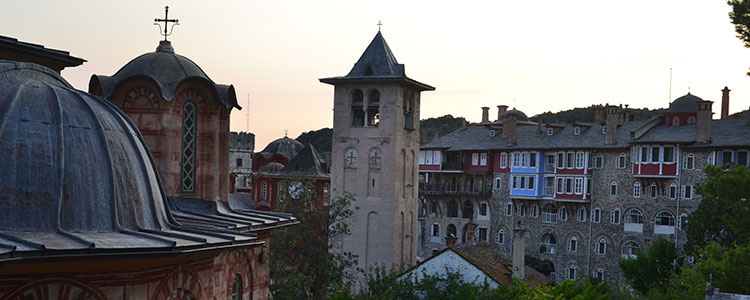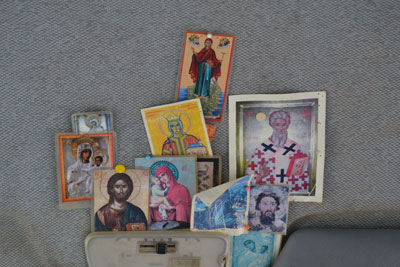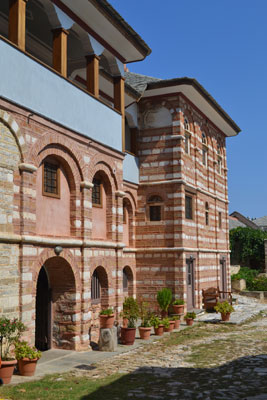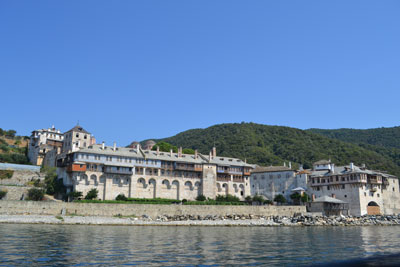A visit to Greece’s Mt. Athos — a standout in a lifetime of travels
This article appears on page 18 of the November 2012 issue.
by Bill Altaffer; San Diego, CA
Following an August ’11, 21-day tour of Azerbaijan, Georgia, Armenia, Belarus and Ukraine, arranged by MIR Corporation (and covered in last month’s issue of ITN), a few of us flew to Greece for a post-trip visit to Mt. Athos, a UNESCO World Heritage Site on a peninsula pointing across the Aegean Sea toward the rising sun. It is home to 20 Eastern Orthodox monasteries and is a self-governed monastic state within the sovereignty of the Hellenic Republic. Visiting it satisfied a longstanding goal of mine.
Getting there
Arriving in Thessaloniki, we were met by our driver for the 2-hour trip through the Greek countryside to Ouranoupolis, a fishing village that is the departure point for visits to Mt. Athos.
According to Athonite tradition, weather forced the Virgin Mary to anchor at Mt. Athos on her way to Cyprus to visit Lazarus. Overwhelmed by the wonderful, wild natural beauty of the mountain, she blessed it and prayed that it be her garden. The mountain was consecrated as the garden of the Mother of God and was off limits to all other women. Even today, no women can visit and only males over 18 years of age can stay overnight or live there.
View this map larger.
A visitor’s permit (€30, or $37) must be purchased ahead of time from offices in Ouranoupolis. All accommodations on Mt. Athos are in the monasteries. Advance reservations are required but are frequently lost in the shuffle, making the entire experience much more of an adventure.
On our scheduled departure day, taking only hand luggage, two of us proceeded to the dock with our newly acquired ferry tickets (under $10 each). We were unable to get on the faster boat, so it took us two hours to reach Daphne (Dafni), the only point of entrance to Mt. Athos.
It was unorganized chaos as we tried to find our previously scheduled minivan to take us to our first monastery. When the dust finally cleared, literally, we somehow found ourselves in the back of a Toyota truck heading down a bumpy dirt road, eventually stopping at the top of a hill. The driver pointed us down a cow path.
With trepidation, we scrambled down it to the gates of a castle, the St. Andreas Skiti monastery, where a meal was about to be served. It felt like entering a soup kitchen on skid row as we marched behind the monks and priests into the cavernous, dark dining hall.
There is never any conversation during meals at the monasteries, as all meals are accompanied by continuous prayer reading.
That first dinner was a tasty, giant piece of halibut, leading us to make the erroneous assumption that the food would be good during our pilgrimage. However, we found that when we expected anything on Mt. Athos to remain the same, it never did.
Following this principle, the quality of our remaining meals at Mt. Athos went rapidly downhill.
A few hours after dinner, the registration office opened and we were assigned a spartan room with four beds, with a WC down the mosaic-lined hall.
Life on Mt. Athos
If you’re contemplating a visit to Mt. Athos, let me warn you that a stay there is completely lacking in comfort.
Sleeping accommodations are shared in dormitories, and there are no amenities. Most facilities provide only Eastern-type floor toilets and no bathing facilities in spite of the heat and dust. Mirrors are rare. There is no coffee.
If rated by stars, these accommodations would be minus two or three — very basic and uncomfortable. One visits Mt. Athos as a pilgrim, not for a vacation or sightseeing.
Everything there seemed to be under repair to the point that some places reminded me of scenes of Berlin after WWII. The disorganization, chaos, long waits and uncertainty involved in moving from place to place were nerve-racking, but moving daily was required, since a person can stay in each monastery for only one night.
Mt. Athos does not follow the civil clock used by the rest of Greece but, instead, operates on Byzantine time. Their liturgical day begins at sunset, in accordance with Old Testament practice, rather than at midnight as in civil time measurement, so the difference between Athonite time and ordinary time is not a fixed offset.
Since sunset time varies by season, clocks showing the Byzantine time have to be continuously readjusted. Currently, they are readjusted once a week, usually on Saturdays. Daily prayers start three hours before sunrise.
After our forced early awakening, we walked a mile downhill to the capital, Karies, a small village with souvenir shops and a café. This café turned out to be the meeting spot at which to wait for transport between monasteries.
We found that English got us by, but all answers were punctuated with “perhaps,” “possibly” and “maybe.” We soon realized that it was essential to ask more than one person the same question in order to determine the correct answer. This would be madness for anyone wanting certainty or structure.
After asking various people, we deduced that a van would leave for the Megiste Laura monastery in four hours. Or so. Maybe. A van eventually arrived to take us and others, packed like sardines, to the tip of the peninsula, under the Holy Mountain, itself, for our second monastic night.
The following day, we found ourselves back at the same café for another long and uncertain wait for transport to our third and final monastery, Vatopediou, dating back to the 10th century. This is one of the largest monasteries on Mt. Athos, with about 125 monks in residence.
There we met Peter Mathew, an American monk from Wisconsin, who talked to us at length about life in the monastery and showed us several revered icons and relics, including bones of prophets, one dried-up ear, parts of the True Cross, and the Virgin Mary’s belt. These items are reputed to be responsible for many miraculous healings.
At Vatopediou, we first heard, then witnessed, the late-afternoon ritual of a monk carrying a semantron, a 12-foot-long wooden plank held perpendicular to his body, which he banged repeatedly to call the monks to worship.
A few final details
On our final day, we returned to Daphne for our boat ride back to Ouranoupolis. In spite of thinking we had reservations, it took most of the day, a great deal of perseverance and even pushiness, which seemed to be standard operating procedure, before we could find space on a returning ferry. But, as in all of our adventures on Mount Athos, we somehow made it work.
I will never forget my time there. Like other great travel experiences, it was uncomfortable and difficult and I would never do it again, but it was unique and is a priceless memory I would not trade for anything.
Mt. Athos is well policed to keep outsiders and women from entering. The daily number of pilgrims allowed is strictly limited and controlled. This is a man’s land. Even in the chapels, almost all of the icons are depictions of male saints, with only a rare Virgin Mary.
Both room and board at all monasteries are free. If you go, keep your list of prearranged monasteries with you, as you will need to show it in order to be directed to the right spot, though our prior arrangements did not always seem to be confirmed and most monasteries would probably take you in anyway.
It is a good idea to go with a traveling buddy, since it will take at least two of you to figure out what to do and where to go. One of you will hear one thing, and the other will hear something else entirely.
Vans are the only means of transport, and they leave only once a day from the monasteries — very early. There are no tour guides. Our pilgrimage was made strictly by the seat of our pants, which, by the way, could not have been shorts. Conservative dress is required.
Speaking quietly at all times and showing up for prayer before meals are proper behavior.
Some pilgrims buy walking sticks and hike between monasteries. Some climb up the peak of the Holy Mountain to its summit (2,000 meters high) and spend the night in the small chapel there.
The gates of the castle-like structures of the monasteries close at about 8 p.m.
Tap water on Mt. Athos comes from natural springs and is safe to drink.
Cat lovers will be delighted to see numerous healthy cats at each monastery.
Planning a visit
You should allow a full week for this visit, including an initial night or two in Ouranoupolis and at least one there after your pilgrimage.
Anyone wishing to visit Mt. Athos must obtain a written permit to do so from the Holy Executive of the Holy Mount Athos – Pilgrims’ Bureau (109 Egnatia St., Agioritiki Estia Building, Thessaloniki, Greece; phone +30 2310 25 78, fax +30 2310 22 24 24 or e-mail piligrimsbureau@c-lab). Reservations must be made six months in advance.
Once approval has been granted, the permit must be picked up in person at the Ouranoupolis branch of the Pilgrims’ Office. (A passport /ID is required.)
The office in Thessaloniki is open 9-4 Monday-Saturday; in Ouranoupolis, hours are 7:30-1:00 Monday-Sunday.
Only 10 permits per day are issued for non-Orthodox visitors. These permits are valid for a 4-day visit on the dates specified. Anyone who makes arrangements by phone should mail (not fax) a copy of his passport to the office and call two weeks before the date of the visit to confirm the reservation.
Upon arrival in Ouranoupolis, the port where the boats depart for Mt. Athos, you must obtain a residence permit (Diamonitirio, €30), which allows accommodation at the monasteries of your choice.
Finally, in my opinion, Mt. Athos has much more to offer than does the Vatican. It features simple monastic life, not tourist-filled monumental buildings, and is the ultimate locale in which to completely escape from modern life and reflect on your needs. Men of any faith can apply to visit.
Going there is not for everyone. We returned to Ouranoupolis filthy, unshaven and hungry, physically worn out from our experience but rejuvenated in spirit. The contrast between this and the earlier part of our trip with MIR Corporation made it all the more meaningful, and it was truly a high point in my travel experiences.




